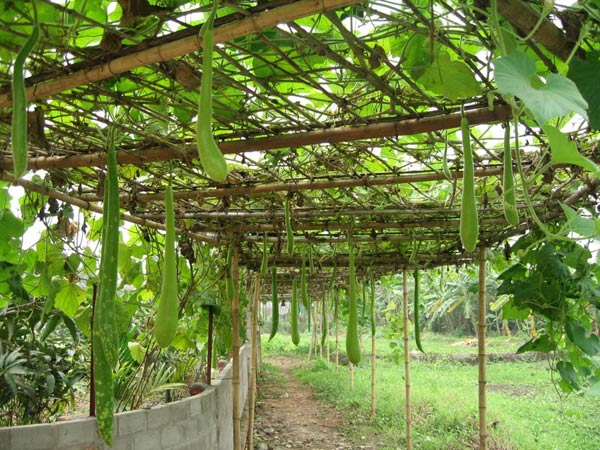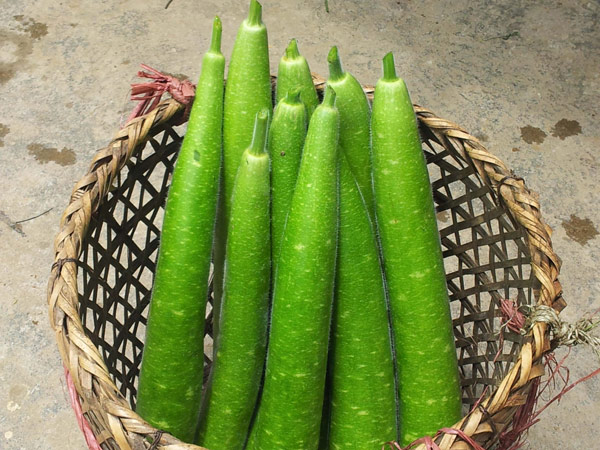Planting techniques and care for many gourds
Thanks to the possession of a technique that is not too complicated, the tree truss has the effect of creating shade and is a raw material for many delicious dishes, so the gourd is grown and used in many places.
The gourd has a scientific name is Lagernaria siceraria (Molina) Standl, belongs to Cucurbitaceae family, has quite simple planting techniques. Gourds of African and Indian origin are now widely grown in tropical and subtropical countries worldwide.

The gourd is not difficult to plant, so it is grown in many places.
The gourd is an annual tree, the stem is tied up, the branch is branched, the stem is strong and has a large branch so it is necessary to press the tops and stems. The root system is very developed, spread widely, capable of producing many unstable roots in burning. Flowers pollinate by wind and insects. The fruit has a very variable shape and size, usually cylindrical, 50 - 100 cm long, when old, the fruit is peeled, the gourd has a temperature of 20-30 degrees Celsius and strong light intensity, so Summer vegetables.

In order to get wrong fruit pots, people should pay attention to follow some basic planting techniques.
Currently, there are many varieties of gourd but mainly 4 types: size, gourd, white and round. However, in the North, people should plant pots because they produce high productivity and stable income.
The pots are grown all year round, the dry season gives more fruits to the rainy season. The growing pots are favorable when growing from November to January. Gourd seeds need high temperatures and adequate humidity to germinate.
Planting techniques
Growers should soak seeds from 10-12 hours, then pack seeds in hot ash or sand for 4-5 days to germinate. Farmers planted seeds to sprout seeds in the soil to care for until they have two real leaves to grow. In addition, people can also plant seeds directly in the field, each hole is from 3 to 4 seeds, dig a hole with the size of 50 x 50 x 30 cm, the hole is 1m apart, apply manure or grass manure and about 100 g of NPK mixture for each cavity before planting.
Gourds need lots of water, so caregivers have to water regularly 1-2 times a day for plants that are moist enough. The amount of irrigation water needs to increase when the gourd bears fruit. The growth period lasts from planting to election to the rig (60 days after planting), people need to apply regularly once a week to prepare facilities for flowering plants.

Cool gourds should be used quite a lot.
The flowering, fruiting and growing plants need to be applied once every 7-10 days with the amount of fertilizer increasing gradually to the left and big fruits. During the cultivation period (130-140 days), each cavity should be applied from 1 - 1.5 kg of NPK mixed fertilizer.
When the gourd grows 1 meter long, farmers start to circle the original ring, take the soil to block it immediately to burn it, the way 1-2 burning to stop the soil to take advantage of the election of uncertain roots, increase the ability to attract nutrition to the left later . Two months after planting, new people should rely on ropes to climb rigs, need to stay in the natural position, do not overturn or twist the rope. Should do a rig to vote enough area to crawl, vote on the truss can be fruit and flower. From 75 to 90 days after planting, pots begin to harvest.
Elect many branches and carry fruits in the branch line.Branch lines in the stem from the base up to the truss should be removed to make the stem open . When voting on rigs, growers should not prune the branches for fruit. Once the fruit has been collected on the branch, people should press the tip to make the fruit grow big and continue to keep it left on another branch.
Gourd pests include leafy flies (Lyriomyza spp.), Aphids (Aphis sp.), Melon bugs (Aulacophora similis). People need to spray quickly when they see these insects appear.

Shrimp-cooked gourd soup is a favorite summer snack.
Common pests and diseases such as seedling wilt disease caused by fungus Rhizoctonia solani, viral mosaic disease, anthracnose disease caused by fungus Colletotrichum lagenarium during the rainy season and powdery mildew disease caused by Sphaerotheca fuliginea in the dry season. In fact, due to the small area planted, the economic value of the gourd is not high, farmers may not be able to prevent treatment, only to remove the diseased plant or to remove the diseased leaves if any.
Harvest and breed
The gourd grows 10 - 12 days after flowering, so people can harvest to eat.Growers should cut the fruit when the skin is soft, the fruit is long, the inside is just as good. People should not leave the old fruit, the seed skin inside is hard, eat poorly and the tree is quickly decayed. If you take good care, 100-stem pots will be left to harvest every 2-3 days; Each root has an average of 10-15 fruits.
The use of gourd
The percentage of nutrients in the gourd is lower than that of other plants in the family but the juicy fruit flesh has a cooling effect, except for poison, can cure diabetes and acne. Flowers and gourd seeds are also used as medicine in Oriental medicine. Very hard old pods are used for making bottles, jars or making home appliances.
- Techniques to plant and care for ornamental figs
- Techniques for planting rare and precious milk plants
- Techniques for growing the scallop orchids in pots
- Technical guidance on planting and caring for geraniums
- Cultivation and care of cabbage techniques change the style of Tet decoration
- Planting techniques and care of apricot flowers for Tet holiday
- Techniques for growing stone lotus in pots
- Techniques to plant and care for cacti
- The precious tree planting technique brings rich fortune to homeowners
- How to grow safe cowpea for households
- Techniques for growing avocado trees
- Techniques for growing and caring rhododendron flowers in Tet season
 'Barefoot engineer' invents a pipeless pump
'Barefoot engineer' invents a pipeless pump Process of handling dead pigs due to disease
Process of handling dead pigs due to disease Radiometer
Radiometer Warp Engine: Technology brings us closer to the speed of light
Warp Engine: Technology brings us closer to the speed of light